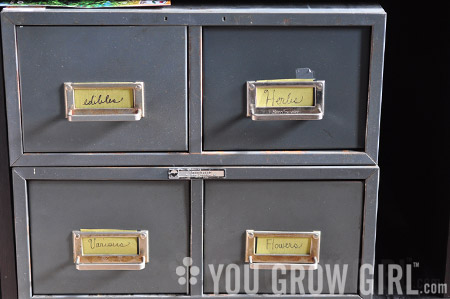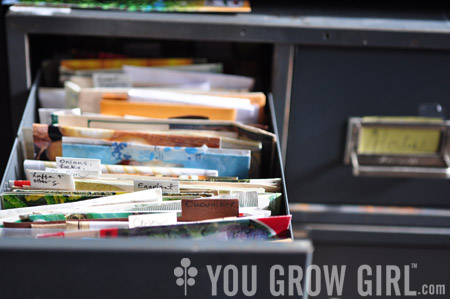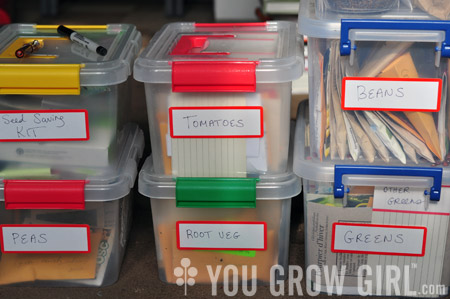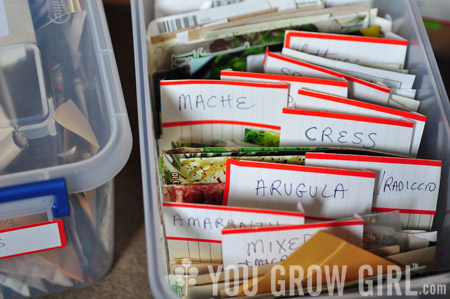
I’ve flirted with and tested out countless cheap and cheerful seed organization systems through the years. From plastic storage bins, to glass jars, wicker baskets, and vintage index card boxes — I’ve tried out every affordable option I could think of and then some. As my rag-tag seed bank has grown, I have had to conjure up new and smarter ways to keep on top of countless little packets.
A few weekends ago I realized that once again my seed collection was out of control and needed to be revamped. Years of experience has made it clear to me that I require three systems: One for the plants that are started indoors underneath lights, another for the seeds that are direct sown, and a third for tomatoes.

Seeds That Are Sown Indoors:
This includes long-season vegetables such as eggplant and peppers, annual flowers, perennials, herbs, and assorted cacti, succulents, etc.
Seeds that are started indoors are fine when kept in a permanent system as I find that they do not need to be accessed very often and can be easily retuned to the drawer once I am done sowing.
I have a metal filing drawer next to my desk that I use to hold some of my collection and while the system works fairly well, it is not nearly large enough to contain my seed stash.Last fall, on a road trip to visit Margaret, we stopped at a Salvation Army along a country road where I found two, vintage, twin-drawer metal index card filing systems for $4. As you can see in the above photo, I have organized the four drawers around plant types. Unfortunately I am not sure how long this system will suffice without another drawer unit as all of the drawers save “Various” are full.
Since I did not have index card-sized dividers, I made my own by affixing small, peel and stick tags to regular index cards and construction paper cut down to size. Within each drawer, plants are divided alphabetically or by type.

Seeds That Are Directly Sown Outside:
Back when I did the bulk of my gardening on a rooftop, I kept the direct sown seeds in a basket next to the door where I could grab them at will for easy planting. That system worked; however, now-a-days I have a lot more seeds and do not have the space by my current door to house several baskets.
Instead, I’ve been using these plastic storage bins that are just wide enough to hold one row of seed packets. Some of the bins were purchased at the dollar store and have handles, making them super easy to take outside and bring back in. This year I have had to add more bins, so I decided to divide them up by type: root vegetables, greens, beans, peas, and a few extras to hold my self-saved overflow.

Inside each bin are dividers that break down the larger category further by subcategories.
For example: Root Vegetables are divided up further to include radishes, carrots, beets, turnips, and miscellany. The dividers are simply index cards turned sideways with sticker labels affixed to the top. Both the index cards and the labels were only a few bucks at the dollar store.
So far I have found it very easy to find what I am looking for, and the hope is that when I need to sow beets, I will simply grab the bin, head outdoors, sow the seeds, and return them to their place within the bin. No more misplaced seed packets that I find months later stuffed inside coat pockets and junk drawers. Or worse still, like the case of the missing lettuce when it took me over a year to locate a tin that held 50 lettuce varieties!
Tomatoes:
Tomatoes are a category onto their own simply because I have so many of them! I prefer that they are portable since it is easier to keep track of the large number of varieties that I sow in just a few batches.
Someday — some magical, glorious day — I would like to improve my system overall by plugging each plant into an Excel document. But since that requires free time that I don’t have and having to actually use Excel (which I abhor), I think this step will have to be left in the realm of fantasy.
Update (Feb 2014): Now that I’ve been living with these systems for some time I thought it necessary to update with further thoughts. Aesthetically, the filing cabinet is the best, and while it is useful, it comes with one negative: temperature regulation. I keep the cabinets in my office and away from direct light, so it doesn’t suffer too many highs except for a few days in the summer. In the positive, they breath better than plastic does. I haven’t noticed any issues with humidity. Still, I am careful about the seeds I keep in it. On the other hand, the plastic bins are great because I can easily shift them around the house with the seasons. They go in the cool basement in the summer and to a cool, but not freezing location through the winter months. For this reason, I keep my self-saved seed in their own bins. Since I often use those seeds for sale or trade, I am most concerned that they are not subjected to too much heat or humidity.
Ooh, I like the idea of separating indoor-started and direct sewn seeds. That would be smarter than hauling all my seeds out all summer long. I think I’ll be doing some re-organizing myself. Thanks for the ideas!
I separate my seeds into the broad vegetable, herb, annual, perennial, and biennial categories and then alphabetize by species (common name) within each category. I store them in five plastic shoeboxes. I do like the idea of creating a separate tomato box, as I have a lot of smaller packages of tomato seed from trades and they can get lost in the ‘T’ section of the vegetables!
Two summers ago I created a “sowing kit” which has my plant markers, UV resistant pen, a ruler (for reminding myself what 1/2″ looks like), and a pencil (for making divots if need be). It’s inside a smaller plastic shoebox: about half the length of the plastic container’s in your photo. When I’m ready to sow seeds, I remove the packages from the main storage boxes and add them to the sowing box. That way I’m only exposing the seeds that I’m planting to the potential extremes in temperature & humidity. Also, the box has a lid, so if it starts to rain, I can quickly protect the seed packages from moisture.
The sowing box and storage box combination also works for me as I track planting dates and my seed stash with folia. When I come in from planting I create new plantings for each item on folia as I either file the package back into the storage box, or archive the seed stash item (if the envelope is empty.) Then the sowing kit is all ready for the next time I need to plant outdoors. It’s eliminated much of the “where did I leave the marker/plant tags?” time wastage too which is a nice bonus!
This sounds very useful … I think I’ll see if I can find (or make) a big 3ring pencil case for my binder system and make a planting kit that I can find even though it winds up living in a mobile home depending on what time of the year it is … hmmm
I have mine separated by dates, like 12 weeks before frost, 8 weeks, etc, referring to when they have to be planted. Indoor or outdoor, at 8 weeks before May 11, I know which seeds to grab and plant. Seems to work nicely :)
I’m going to take a closer look at trying to integrate that into my binder system … maybe put the early seeds in the front with tab dividers WOAH nice tip!
This is a great way to organize. Alas, will not work for me as there are so many types that I sow multiple times throughout the season.
My seed collection is not nearly as large as yours, and I still use the old glass jars. I’ve got them sorted into three categories- vegetables in one jar, herbs, flowers and other ornamentals (like oranges which I hope to grow a plant from one day but never expect an actual orange to eat) in another jar and a third jar which holds the seeds I’ve shuffled off the current plans. Not going to plant this year, maybe next time… I tend to sort them all again in the winter when I’m bored. If I had as many seed packets as you, they definitely wouldn’t fit in my fridge. Don’t you find the need to keep them cold…? (My mom used to save hers in an unheated garage but I don’t have such).
I keep them as cold as I can without freezing.
I like your categories. I am going to see if I can refine my system further (say it every year but I still find surprise packages everywhere. I have binders with photo sleeves that I’ve been using that seem to be pretty good (when I remember to always put the packages back where they belong) … (green for seed starting indoors, brown for outdoor, red for tomatoes, etc) and it’s been working as well as a system can for me. I discovered 3-ring photo slide sleeves and bought those little zip lock baggies at the Dollar Store to fit them perfectly, too. It’s surprising how much room becomes dedicated to seed-keeping really. heheh
A separate system just for tomatoes! This is something I can understand.
Do you find your seeds stay viable for a long time if not refrigerated? I keep mine in the fridge but I sense some family resistance coming on as the seed collection grows and non-seed fridge real estate diminishes. Perhaps my true problem is my tendency to treat the seeds as if they were long-term investments…
Really like your index card boxes. Where did you find them?
I’ve been on a search for old card catalogs, but they’re impossible to find in Seattle.
I’ve got my seeds in a big red pleather makeup case. It was given to me by a grandmother (of course filled with makeup). I tossed the make-up, but love it for seeds. I’ve only got two broad categories: all edibles & herbs on one side, all flowers and landscaping plants on the other. It’s far too small for my seed collection now, but I’m reluctant to give it up, now that my grandmothers are gone. Maybe I should keep it for half my collection and get another container for the other half.
I am just beginning a vegetable garden tradition and definitely need to follow in your organizing footsteps! My question is about “shelf-life”. How long can you leave the seeds stored away before they are too old to germinate? On average of course :)